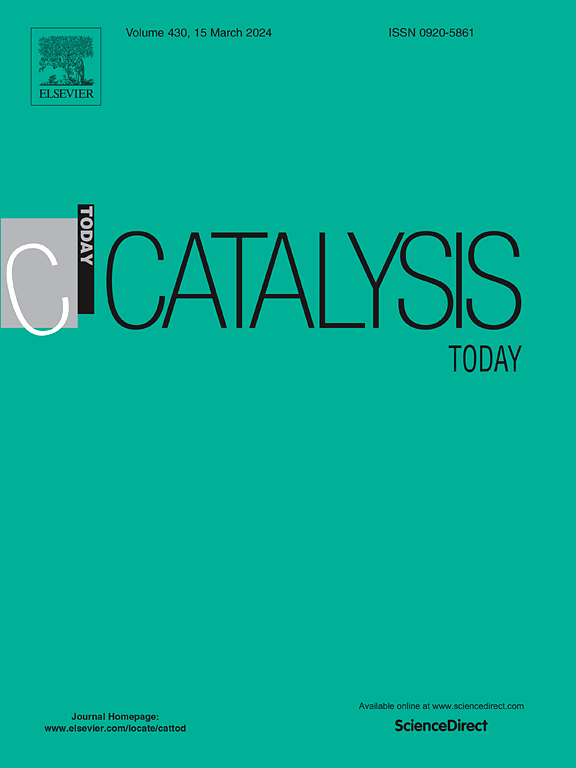掺杂GQD负载的硫化钴纳米复合材料:一种具有优异氧电极性能的缺陷工程方法
IF 5.2
2区 化学
Q1 CHEMISTRY, APPLIED
引用次数: 0
摘要
开发高效、耐用的氧电解电催化剂对推进清洁能源技术至关重要。然而,氧还原反应(ORR)和析氧反应(OER)的缓慢动力学以及催化剂降解仍然是主要障碍。在这里,我们优化了复合纳米催化剂的组成,通过将电子缺陷的b原子掺杂到石墨烯量子点(GQD)中,并与硫化钴(CoS)纳米结构相连。通过对催化剂表面结构的优化和界面相互作用的研究,该催化剂表现出优异的氧电极反应性能。缺陷工程BGQD和CoS之间更快的电子协同作用为电解过程提供了更多的催化活性位点,以及更快的电导率和更高的氧化中间体在电极表面的吸附/解吸速率。在优化后的复合电极材料中,CSBGQD-13 (CoS/BGQD(1:3))具有较高的正起始电位(Eonset = 1.04 V vs. RHE)和半波电位(E1/2 = 0.84 V vs. RHE),在1600 rpm下具有7.6 mA/cm2的极限电流密度,并且在ORR过程中具有合理的抗MeOH交叉效应。此外,我们的电催化剂表现出长期耐用性和有效的OER活性,在电流密度为10 mA/cm2时,与RHE相比,该电催化剂的Tafel斜率最低,为82 mV/dec,过电位较低,为0.27 V。此外,CSBGQD-13对ORR和OER具有优异的双功能电催化性能,其ΔE值非常小(与RHE相比仅为0.66 V),催化电流密度较高。因此,对于可能的燃料电池应用,我们相信这种电极材料可以提供对金属硫化物碳点杂化催化剂原理的理解。本文章由计算机程序翻译,如有差异,请以英文原文为准。
B-doped GQD supported cobalt sulfide nanocomposite: A defect engineering approach for superior oxygen electrode performance
Developing an efficient and durable electrocatalysts for oxygen electrolysis is crucial for advancing clean energy technologies. However, the sluggish kinetics of oxygen reduction reaction (ORR) and oxygen evolution reaction (OER), along with catalyst degradation, remain major obstacles. Here, we optimized the composition of composite nanocatalysts obtained by doping of an electron deficient, B-atoms into graphene quantum dots (GQD) attached with Cobalt Sulfide (CoS) nanostructures. Optimizing the surface structure and investigating the interfacial interactions, the catalyst demonstrated an exceptional oxygen electrode reaction performance. The faster electronic synergism between the defect engineering BGQD and CoS offers more catalytic active sites as well as faster electrical conductivity and higher adsorption/desorption rate of oxygenated intermediates at the electrode surface for the electrolysis processes. Among the optimized composite electrode material CSBGQD-13 (CoS/BGQD (1:3)) exhibited high positive onset (Eonset = 1.04 V vs. RHE) and half-wave potential (E1/2 = 0.84 V vs. RHE) with high limiting current density of 7.6 mA/cm2 at 1600 rpm and a reasonable resistance to the MeOH crossover effect during ORR. In addition, our electrocatalyst demonstrated long-term durability and effective OER activity with the lowest Tafel slope of 82 mV/dec among other CSBGQDs and a lower overpotential of 0.27 V vs. RHE at a current density of 10 mA/cm2. Furthermore, the CSBGQD-13 claims excellent dual function electrocatalytic performance towards ORR and OER with a very small ΔE value (only 0.66 V vs. RHE), a higher catalytic current density. Henceforth, for possible fuel cell applications, we believe that this electrode material may provide an understanding of the principles of metal sulfide carbon dots hybrid catalysts.
求助全文
通过发布文献求助,成功后即可免费获取论文全文。
去求助
来源期刊

Catalysis Today
化学-工程:化工
CiteScore
11.50
自引率
3.80%
发文量
573
审稿时长
2.9 months
期刊介绍:
Catalysis Today focuses on the rapid publication of original invited papers devoted to currently important topics in catalysis and related subjects. The journal only publishes special issues (Proposing a Catalysis Today Special Issue), each of which is supervised by Guest Editors who recruit individual papers and oversee the peer review process. Catalysis Today offers researchers in the field of catalysis in-depth overviews of topical issues.
Both fundamental and applied aspects of catalysis are covered. Subjects such as catalysis of immobilized organometallic and biocatalytic systems are welcome. Subjects related to catalysis such as experimental techniques, adsorption, process technology, synthesis, in situ characterization, computational, theoretical modeling, imaging and others are included if there is a clear relationship to catalysis.
 求助内容:
求助内容: 应助结果提醒方式:
应助结果提醒方式:


